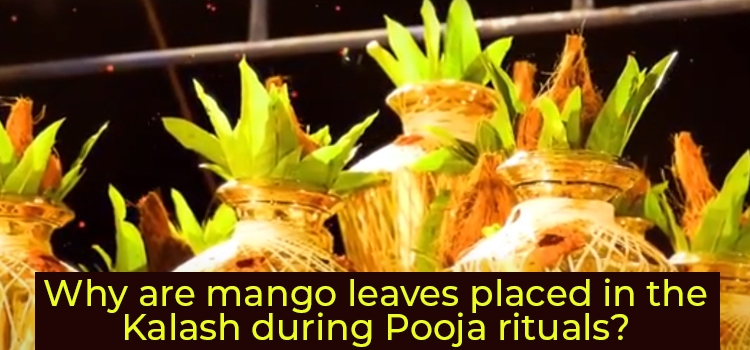Why are mango leaves kept in the kalash during puja ritual?
Kalash is an auspicious symbol in Hindu religion and culture. It is a copper pot with a small mouth and a big base. It is also called Poorna kumbha or Poorna kalash or Poorna ghata. According to the Rig Veda, Poorna kumbha signifies abundance and life source.
The Skanda Purana says that the kalash came into being during the Samudra Manthan or the great churning of the Milky Ocean. Lord Vishnu, in the form of Dhanvantari, the god of Ayurveda and the divine physician, emerged from the ocean during the churning, holding the kalash filled with the nectar of immortality. All deities are said to reside in the kalash. Therefore Kalasha Pooja ritual enjoys an important place in Pooja ceremonies to worship various deities.
Kalash symbolizes abundance and wisdom. Many Hindu gods like Shiva, Brahma, and Lakshmi are depicted holding a kalash in their hands. Some devotees believe that kalash is a personification of Lord Ganesha, the deity who removes obstacles from our lives, and Gauri Devi, goddess of household wealth. Kalash, a symbol of the Goddess or Devi, is worshipped during Hindu festivals associated with childbirth and marriage. It is usually placed at the entrance of houses to indicate welcome, and facing the north, in the center. The north represents balance, and by placing kalash in the north, it implies that we are inviting balance and happiness into our lives.

Participate in AstroVed’s 3-Day Overall Health and Protection Ceremonies
There are different spiritual and religious meanings behind the practice of using kalash during Pooja ceremonies. Let us examine some of them.
Some believe that the metal pot is a symbol of fertility. It stands for the earth and the womb, both of which provide and nourish life. The mango leaves represent Kama, the god of love. We use it to invoke the pleasurable aspect of fertility. Coconut signifies prosperity and power. The water in the pot signifies the life-giving principle of the universe.
It is believed that kalash embodies all the gods and creates subtle variations which can purify and enhance us. The mango or betel leaves in it represent the deity’s seat. The water in it keeps the water purified for a long period. Coconut has the power to attract divine principles and transmit them to the water.
Kalash is a microcosmic portrayal of the cosmos. The water in it supposedly paved the way for creation. The leaves and coconut signify the different creations in the universe. The thread signifies the love that binds everyone.
During the Pooja, deities are invoked, and the kalash is used for preparing seats for the invoked deities. First, the pot is filled with water, and then mango or betel leaves are placed in it. These leaves are the deity’s seat. The divine principle is attracted to these leaves and the water in the kalash keeps the seat pure until the ritual of Pranapratishta (invoking deity into an image, idol, coconut, or betelnut) is completed. In this manner, the invoked divine principle stays for a long time.
Into the kalash, a betel nut or some coins are placed, and then a coconut is placed on the pot’s mouth. The coconut tuft attracts the deity principle from the surrounding atmosphere. It is then transmitted to the water kept in the pot through the body of the coconut.
The water is very clean and pure, because of which it can attract the sattvik particles of the divine frequencies. But there are fewer raja particles, and therefore its capacity to project the sattva particles is poor.
Putting a coin symbolizes sacrifice. There is a sacrifice of wealth through this medium, and jiva (embodied soul)’s attachment is also reduced. This enables the worshipper to get more benefit from the sattvikta of the Pooja ritual. A copper coin is also put in the kalash. Copper is more able to project sattvik frequencies. It enables the emanation of sattvik frequencies that are present in the water into the atmosphere.
A betel nut is also kept in the pot. Betelnut can increase the sattva and raja components in the water kept in the pot. This enhances the ability of the water to emit the manifest principle of the deity. The betel nut has particles related to the absolute earth element, which can bind the sattva particles related to the sattva component. This helps to retain the sattvikta of water for a long time. Five precious stones like diamond, pearl, emerald, blue sapphire, gold, and ruby are also added to the water in the kalash. These five precious stones and gold can attract and emit the principles of five superior gods. This greatly benefits the worshipper. But nowadays, precious stones and copper use is much reduced, and instead, alloys are used, which don’t give much spiritual benefit.



















